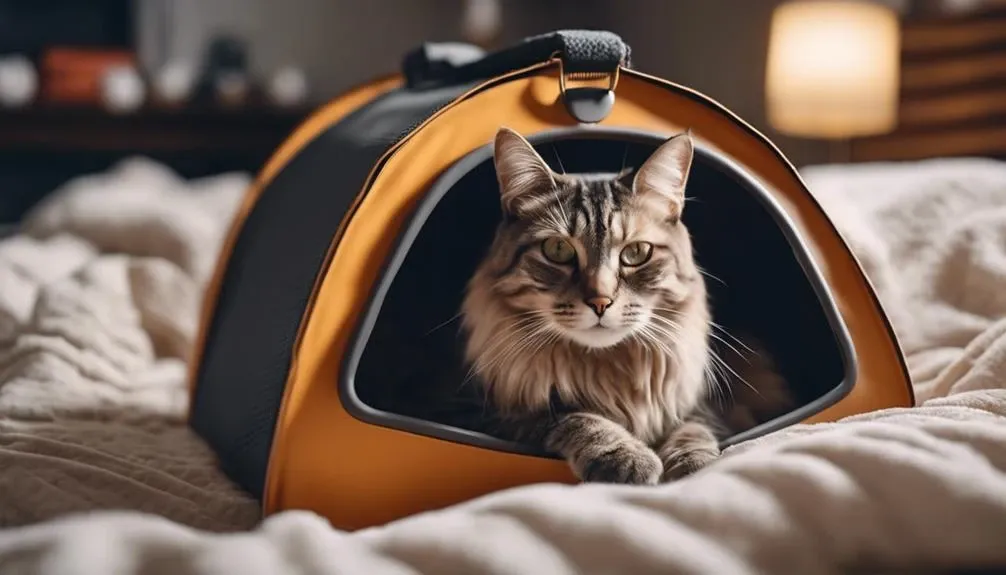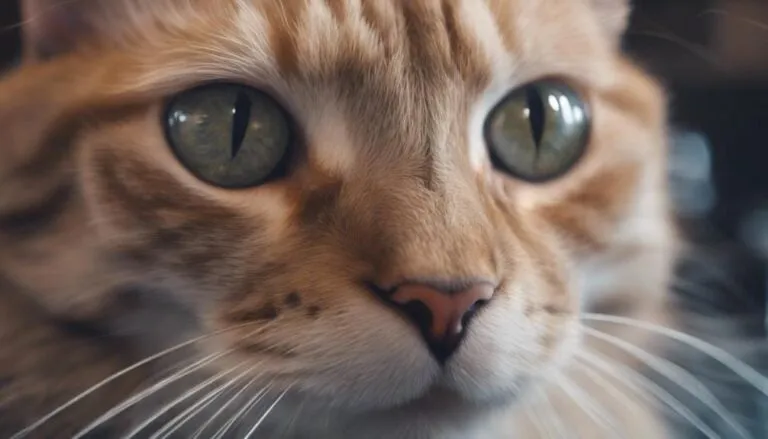The Best Fluffy Pancakes recipe you will fall in love with. Full of tips and tricks to help you make the best pancakes.

Exploring the realm of cat carrier training unveils a world where finesse and precision intertwine to create a harmonious bond between feline and carrier. As cat owners navigate the intricate landscape of training their beloved companions, a myriad of challenges and triumphs await.
With each step carefully calculated and every interaction tailored to the individual cat's needs, the art of mastering cat carrier training transforms into a journey of discovery and understanding. Join us as we unravel the secrets behind successful carrier training and embark on a path towards fostering trust and cooperation with our feline friends.
Key Takeaways
- Keep carriers in everyday environment to familiarize cats
- Use positive interactions and scents to make carriers appealing
- Train cats gradually to enter and stay calm in carriers
- Utilize step-by-step methods for successful carrier training
Understanding Cats' Carrier Aversion
Understanding cats' aversion to carriers is crucial for effectively training them to overcome their fear and anxiety associated with these transport containers. Overcoming resistance through behavior modification techniques is key in this process.
Cats often resist carriers due to past negative experiences or feeling confined, leading to stress and anxiety. Behavior modification involves gradual desensitization to the carrier by making it a positive and familiar space for the cat.
Significance of Carrier Training
The training of cats to acclimate to carriers is crucial for ensuring their well-being during necessary transportation and veterinary visits. Building trust and minimizing stress are key components of carrier training for cats. By gradually introducing cats to carriers and creating positive associations, the overall stress and anxiety related to carrier use can be significantly reduced. Through consistent training and positive reinforcement, cats can learn to view carriers as safe spaces rather than sources of fear or discomfort. This process helps to make vet visits and travel less stressful for both the cat and the owner.
- Building trust through positive interactions
- Gradual acclimation to the carrier environment
- Providing rewards and reassurance during training
- Creating a sense of security and comfort within the carrier
- Minimizing stress by making the carrier a familiar and safe space
Enhancing Carrier Appeal for Cats
To make cat carriers more enticing for feline companions, implementing strategies that appeal to their natural instincts and preferences can significantly enhance their overall acceptance of the carrier.
Scent enrichment plays a crucial role in making the carrier appealing to cats. Placing a blanket with the cat's scent inside the carrier can help create a familiar and comforting environment. Additionally, using pheromone sprays on the carrier can further attract the cat due to its calming effect.
Interactive play near the carrier can also increase its appeal. Engaging the cat in positive interactions, such as playing with their favorite toys or offering treats around the carrier, can create positive associations, making the carrier a more inviting space for the cat.
Step-by-Step Training Guide
Effective cat carrier training involves implementing a gradual approach to familiarize your feline companion with the carrier in a positive and stress-free manner. To achieve this, follow these steps:
- Start by placing the carrier bottom on the floor with a blanket
- Reward cat for staying on the blanket with treats and fuss
- Gradually move cat into the bottom half of the carrier
- Introduce the top half of the carrier with treats inside
- Encourage cat to enter the carrier without closing the door
Mastering Gradual Door Closing
Implementing the gradual door closing training technique is a crucial step in acclimating your cat to the carrier for stress-free transportation and vet visits. This method focuses on building trust and confidence in your cat towards the carrier.
Begin by placing the carrier door without closing it, allowing your cat to investigate. Reward your cat for showing curiosity and encourage them to enter the carrier with treats. Slowly close the door while providing treats through the openings, ensuring your cat remains calm and comfortable.
Once your cat is at ease with the door closed, lock it gently. This gradual approach helps your cat feel secure and builds their confidence in the carrier, making future travels less stressful for both you and your feline companion.
Skillfully Handling Carrier Movement
How can you ensure your cat remains calm and comfortable during carrier movement training sessions? When handling carrier movement, it's vital to employ calming techniques and behavior modification strategies. Here are some tips to skillfully handle carrier movement with your feline companion:
- Use gentle carrier lifting techniques: Lift the carrier slowly and smoothly to prevent sudden movements that may startle your cat.
- Incorporate calming techniques: Talk softly to your cat while moving the carrier to help reassure them.
- Practice gradual carrier shifting: Shift the carrier gently from side to side to accustom your cat to movement.
- Implement behavior modification: Reward your cat for staying calm during carrier shifting to reinforce positive associations.
- Provide a comfortable environment: Ensure the carrier is padded and secure to minimize any discomfort during movement.
Implementing Positive Reinforcement Techniques
When training your cat to become comfortable with carrier movement, incorporating positive reinforcement techniques can significantly enhance their learning experience and overall adjustment to the carrier. Using treats, praise, and interactive play can create a positive association with the carrier.
Employing clicker training can help shape desired behaviors, while desensitization and counter conditioning can reduce fear and anxiety. Additionally, incorporating toys and confidence-building exercises can help build your cat's comfort and trust with the carrier.
Sustaining Cat Carrier Training Success
To maintain long-term success in cat carrier training, consistently reinforce positive associations with the carrier through regular interactions and rewards. Building trust and maintaining motivation are crucial aspects of sustaining cat carrier training success. Here are some tips to help you continue your cat's carrier training journey:
- Regular Interactions: Spend time near the carrier, interacting positively with your cat.
- Consistent Rewards: Reward your cat with treats or praise for calm behavior near the carrier.
- Patience and Persistence: Continue training sessions regularly to reinforce positive associations.
- Monitoring Progress: Keep track of your cat's responses to the carrier to adjust training methods if needed.
- Seeking Professional Help: If you encounter challenges, consult with a veterinarian or animal behaviorist for guidance.
Frequently Asked Questions
Can Carrier Training Be Effective for Older Cats Who Have Never Been Trained Before?
Training older cats for carrier use can be effective through patience and positive reinforcement. Start slow, implement gradual steps, and make the carrier a positive experience. With time, even senior cats can learn to associate carriers with comfort, easing long trips.
How Can I Help My Cat Feel More Comfortable in the Carrier During Long Car Rides?
In the realm of feline comfort during long car rides, implementing calming techniques and distraction methods can transform the carrier into a sanctuary. Through soothing scents, cozy blankets, and interactive toys, the carrier evolves into a haven of tranquility.
Are There Any Specific Techniques for Training Multiple Cats to Use the Same Carrier?
When training multiple cats to share a carrier, consider their group dynamics and socialization levels. Gradually introduce the carrier, rewarding cooperation. Encourage positive interactions and individual comfort within the carrier to create a cooperative and stress-free experience for all cats involved.
What Should I Do if My Cat Becomes Anxious or Stressed During Carrier Training?
When a cat becomes anxious or stressed during carrier training, implementing desensitization methods and counterconditioning techniques can be beneficial. Positive reinforcement and the use of calming aids, like pheromone sprays, help create a calming environment for the cat.
Is There a Way to Train a Cat to Enter the Carrier Voluntarily Without Using Treats as a Reward?
Clicker training and conditioning can help desensitize cats to carrier entry without treats. Reinforce steps towards entering the carrier with the clicker and gradually fade out treats. Positive reinforcement techniques can create voluntary carrier entry behavior.
Conclusion
In the realm of feline care, mastering cat carrier training is essential for alleviating stress and ensuring a smooth transportation experience. According to a recent study by the American Association of Feline Practitioners, 65% of cats exhibit fear or anxiety when faced with carriers.
By employing strategic methods and positive reinforcement techniques, cat owners can foster a positive association with carriers, ultimately leading to a harmonious relationship between cats and carriers.










